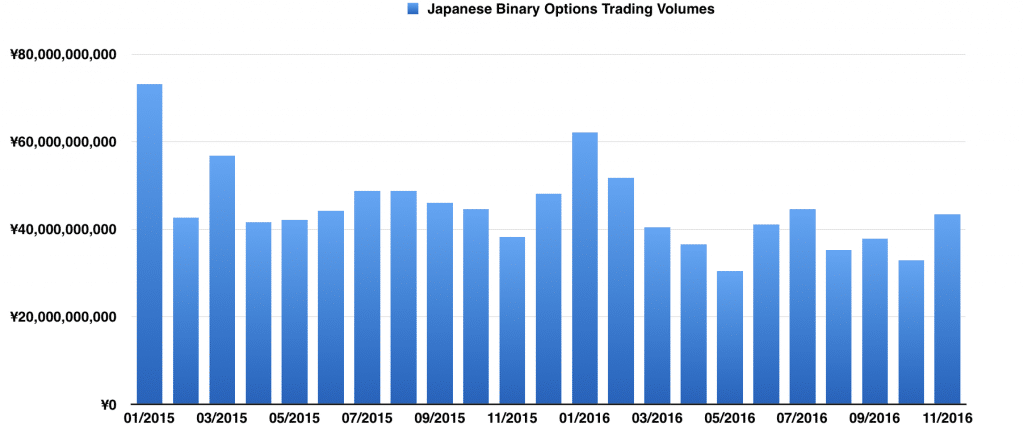Binary Options Trading Volumes in Japan Increase in November
- The regulated part of the binary options industry in Japan rebounded last month.

Japanese binary options traders have generated an increased number of trading volumes in November, a report by the Financial Futures Association of Japan (FFAJ) shows. The Japanese regulator is publishing on a monthly basis the volumes figures of Japanese binary options operators.
Last month’s trading activity has increased materially when compared to October. The number surpassed ¥43 billion ($376 million). The number represents the total across all brokerages that are providing the product in Japan. The number was higher by over 13 percent when compared to last year.

Source: FJAA
The FFAJ regulated product represents a more complex version of the simplistic up and down binary options that are well known in the industry. The so called ‘ladder’ options are providing traders with preset levels which they can choose and bet on an above or below outcome every two hours.
In contrast to their European counterparts the Japanese brokers have to report all of their activity to the Japanese regulators.
The decline in regulated binary options trading in Japan has been pronounced, but last month’s 32 percent rebound represents an optimistic tone for the new year. That said, it can also be related to the unlocking of Volatility Volatility In finance, volatility refers to the amount of change in the rate of a financial instrument, such as commodities, currencies, stocks, over a given time period. Essentially, volatility describes the nature of an instrument’s fluctuation; a highly volatile security equates to large fluctuations in price, and a low volatile security equates to timid fluctuations in price. Volatility is an important statistical indicator used by financial traders to assist them in developing trading systems. Traders In finance, volatility refers to the amount of change in the rate of a financial instrument, such as commodities, currencies, stocks, over a given time period. Essentially, volatility describes the nature of an instrument’s fluctuation; a highly volatile security equates to large fluctuations in price, and a low volatile security equates to timid fluctuations in price. Volatility is an important statistical indicator used by financial traders to assist them in developing trading systems. Traders Read this Term on the markets and a spike in trading pretty much across the board in November.
Japanese binary options traders have generated an increased number of trading volumes in November, a report by the Financial Futures Association of Japan (FFAJ) shows. The Japanese regulator is publishing on a monthly basis the volumes figures of Japanese binary options operators.
Last month’s trading activity has increased materially when compared to October. The number surpassed ¥43 billion ($376 million). The number represents the total across all brokerages that are providing the product in Japan. The number was higher by over 13 percent when compared to last year.

Source: FJAA
The FFAJ regulated product represents a more complex version of the simplistic up and down binary options that are well known in the industry. The so called ‘ladder’ options are providing traders with preset levels which they can choose and bet on an above or below outcome every two hours.
In contrast to their European counterparts the Japanese brokers have to report all of their activity to the Japanese regulators.
The decline in regulated binary options trading in Japan has been pronounced, but last month’s 32 percent rebound represents an optimistic tone for the new year. That said, it can also be related to the unlocking of Volatility Volatility In finance, volatility refers to the amount of change in the rate of a financial instrument, such as commodities, currencies, stocks, over a given time period. Essentially, volatility describes the nature of an instrument’s fluctuation; a highly volatile security equates to large fluctuations in price, and a low volatile security equates to timid fluctuations in price. Volatility is an important statistical indicator used by financial traders to assist them in developing trading systems. Traders In finance, volatility refers to the amount of change in the rate of a financial instrument, such as commodities, currencies, stocks, over a given time period. Essentially, volatility describes the nature of an instrument’s fluctuation; a highly volatile security equates to large fluctuations in price, and a low volatile security equates to timid fluctuations in price. Volatility is an important statistical indicator used by financial traders to assist them in developing trading systems. Traders Read this Term on the markets and a spike in trading pretty much across the board in November.
